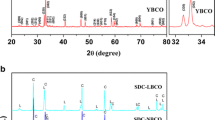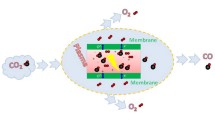Abstract
La0.6Sr0.4Co0.2Fe0.8O3−δ oxides were synthesized by citrate method and hydrothermal method. The oxides prepared by citrate method are perovskite type structure, while the oxides by hydrothermal method have a small amount of secondary phase in the powder. Pyrex glass seal and Ag melting seal provided reliable gas-tight sealing of disk type dense membrane in the range of operation temperature, but commercial ceramic binder could not be removed from the support tube without damage to the tube or membrane. Though the degree of gas tightness increases in the order of glass>Ag>ceramic binder, in the case of glass seal, the undesired spreading of glass leads to an interfacial reaction between it and the membrane and reduction of effective permeation area. The oxygen flux of La0.6Sr0.4Co0.2Fe0.8O3−δ membrane increases with increasing temperature and decreasing thickness, and the oxygen permeation flux through 1.0 mm membrane exposed to flowing air (P h =0.21 atm) and helium (P1=0.037 atm) is ca. 0.33 ml/cm2·min at 950 °C. X-ray diffraction analysis for the membrane after permeation test over 160 h revealed that La2O3 and unknown compound were formed on the surface of membrane. The segregation compounds of surface elements formed on both surfaces of membrane irrespective of spreading of glass sealing material.
Similar content being viewed by others
References
D. Gielen and J. Podkanski, Prospects for CO 2 capture and storage, IEA Publictions, Paris (2004).
K. Thambimuthu, M. Soltanieh and J. C. Abanades, in IPCC special report on carbon dioxide caopture and storage, O. Davidson and B. Metz Eds., Cambridge University Press, London (2005).
A. J. Burggraaf and H. J. M. Bouwmeester, in Fundamentals of inorganic membrane science and technology, A. J. Burggraaf and L. Cot Eds., Elsevier, Amsterdam (1996).
P. N. Dyer, R. E. Richards, S. L. Russek and D. M. Taylor, Solid State Ion, 134, 21 (2000).
Y. Teraoka, H. M. Zhang, S. Furukawa and N. Yamazoe, Chem. Lett., 1743 (1985).
Y. Teraoka, T. Nobunaga and N. Yamazoe, Chem. Lett., 503 (1988).
Y. Teraoka, T. Nobunaga, K. Okamoto, N. Miura and N. Yamazoe, Solid State Ion, 48, 207 (1991).
S. Carter, A. Selcuk, R. J. Chater, J. Kajda, J. A. Kilner and B. C. H. Steele, Solid State Ion., 53, 597 (1992).
Y. Zeng, Y. S. Lin and S. L. Swartz, J. Membr. Sci., 87, 150 (1998).
S. J. Xu and W. J. Thomson, AIChE J., 43, 2731 (1997).
S. J. Xu and W. J. Thomson, Ind. Eng. Chem. Res., 37, 1290 (1998).
J. A. Lane, S. J. Benson, D. Waller and J. A. Kilner, Solid State Ion, 121, 201 (1999).
Q. Xu, D. Huang, W. Chen, J. H. Lee, H. Wang and R. Yuan, Scripta Materialia, 50, 165 (2004).
W. **, S. Li, P. Huang, N. Xu and J. Shi, J. Membr. Sci., 170, 9 (2000).
Z. Shao, W. Yang, Y. Cong, H. Dong, J. Tong and G. **ong, J. Membr. Sci., 172, 177 (2000).
S. Li, W. **, P. Huang, N. Xu and J. Shi, AIChE J., 45, 276 (1999).
K. S. Lim, K. S. Lee, I. S. Han, D. W. Seo, K. S. Hong, K. Bai, S. K. Woo and T. L. Cho, Journal of the Korean Ceramic Society, 38, 886 (2001).
W. J. Weber, J. W. Stevenson, T. R. Armstrong and L. R. Pederson, in Mater. Res. Soc. Symp. Proc., G. A. Nazri, J. M. Taraeson and M. S. Scheiber Eds., Materials Research Society, Pittsburgh (1995).
N. Itoh, T. Kato, K. Uchida and K. Haraya, J. Membr. Sci., 92, 239 (1994).
S. Li, W. **, P. Huang, N. Xu, J. Shi and Y. S. Lin, J. Membr. Sci., 166, 51 (2000).
Author information
Authors and Affiliations
Corresponding author
Additional information
This paper was presented at the 6th Korea-China Workshop on Clean Energy Technology held at Busan, Korea, July 4–7, 2006.
Rights and permissions
About this article
Cite this article
Park, J.H., Park, S.D. Oxygen permeability and structural stability of La0.6Sr0.4Co0.2Fe0.8O3−δ membrane. Korean J. Chem. Eng. 24, 897–905 (2007). https://doi.org/10.1007/s11814-007-0062-2
Received:
Accepted:
Published:
Issue Date:
DOI: https://doi.org/10.1007/s11814-007-0062-2




